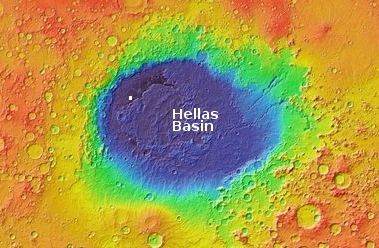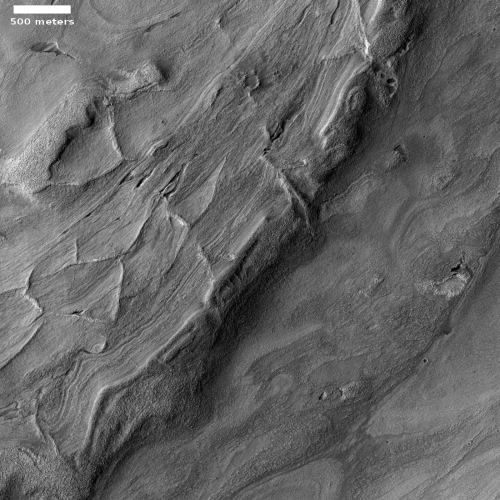The strange squashed ridges at the basement of Mars

Cool image time! The photo on the right, cropped and reduced to post here, was taken by the high resolution camera on Mars Reconnaissance Orbiter (MRO) on April 9, 2020, and shows the very weird and very packed ridges and layers that are found routinely at the deepest part of Hellas Basin, what I have dubbed the basement of Mars.
Be sure to click on the image to see the full photograph. There’s lots more strangeness to see there. And be sure to read my post in the second link, which highlights a similarly strange set of packed ridges, and where I note:
This is the basement of Mars, what could be called its own Death Valley. The difference however is that unlike Death Valley, conditions here could be more amendable to life, as the lower elevation means the atmosphere is thicker.
The context map to the right shows Hellas, with the location of today’s image indicated by the white box, close to basin’s lowest point, more than five miles below the basin’s rim. Overall the Hellas Basin is about the size of the western United States, from the Mississippi River to the Pacific Ocean. It is believed that the entire basin was created by a single gigantic impact that occurred about four billion years ago when the solar system’s inner planets were undergoing what has been labeled the Late Heavy Bombardment.
The specific process that formed these ridges, dubbed honeycomb terrain by scientists, remains unknown however. There are of course theories, none of which are very convincing. Here’s mine, as outlined in the previous post:
[T]he ripples … are truly fascinating, as it is clear that at the highest peaks erosion has ripped those peaks away, leaving behind a hollow shaped by the ripples themselves. These features remind me of some cave features I have seen, where mud gets piled but by water flow, and then is over time covered with a crust of harder calcite flowstone. Later, water then washes out the mud underneath, leaving the curved flowstone blanket hanging in the air.
Here in Hellas Basin it looks like something similar has happened, except that at these peaks the outside crust got broken away, allowing wind to slowly suck out the material underneath, leaving these ripple-shaped pits. Whether it was liquid water or lava that helped create these features, the geology left behind is both beautiful and intriguing. I wonder at the chemical make-up of the crust as well as the materials below. And I especially wonder if there are water sources buried within Hellas Basin.
You can see more of these strange ripple-shaped pits in today’s image.
I wouldn’t take my theory very seriously, but then, no one is enthused about any of the professional theories either.
Because of the depth of Hellas Basin, however, it has that one significant advantage: the Martian atmosphere is thicker, enough to actually increase the possibility of finding liquid water on the surface. And that thicker atmosphere might also be more amenable to the use of flying airships, thus simplifying transport up, down, and about.
Both facts make Hellas Basin a future target for exploration and settlement. The key is water, which as far as I know so far, has not been as clearly documented within the basin. (I could be wrong however, or further research might find it.)
On Christmas Eve 1968 three Americans became the first humans to visit another world. What they did to celebrate was unexpected and profound, and will be remembered throughout all human history. Genesis: the Story of Apollo 8, Robert Zimmerman's classic history of humanity's first journey to another world, tells that story, and it is now available as both an ebook and an audiobook, both with a foreword by Valerie Anders and a new introduction by Robert Zimmerman.
The print edition can be purchased at Amazon or from any other book seller. If you want an autographed copy the price is $60 for the hardback and $45 for the paperback, plus $8 shipping for each. Go here for purchasing details. The ebook is available everywhere for $5.99 (before discount) at amazon, or direct from my ebook publisher, ebookit. If you buy it from ebookit you don't support the big tech companies and the author gets a bigger cut much sooner.
The audiobook is also available at all these vendors, and is also free with a 30-day trial membership to Audible.
"Not simply about one mission, [Genesis] is also the history of America's quest for the moon... Zimmerman has done a masterful job of tying disparate events together into a solid account of one of America's greatest human triumphs."--San Antonio Express-News

Cool image time! The photo on the right, cropped and reduced to post here, was taken by the high resolution camera on Mars Reconnaissance Orbiter (MRO) on April 9, 2020, and shows the very weird and very packed ridges and layers that are found routinely at the deepest part of Hellas Basin, what I have dubbed the basement of Mars.
Be sure to click on the image to see the full photograph. There’s lots more strangeness to see there. And be sure to read my post in the second link, which highlights a similarly strange set of packed ridges, and where I note:
This is the basement of Mars, what could be called its own Death Valley. The difference however is that unlike Death Valley, conditions here could be more amendable to life, as the lower elevation means the atmosphere is thicker.
The context map to the right shows Hellas, with the location of today’s image indicated by the white box, close to basin’s lowest point, more than five miles below the basin’s rim. Overall the Hellas Basin is about the size of the western United States, from the Mississippi River to the Pacific Ocean. It is believed that the entire basin was created by a single gigantic impact that occurred about four billion years ago when the solar system’s inner planets were undergoing what has been labeled the Late Heavy Bombardment.
The specific process that formed these ridges, dubbed honeycomb terrain by scientists, remains unknown however. There are of course theories, none of which are very convincing. Here’s mine, as outlined in the previous post:
[T]he ripples … are truly fascinating, as it is clear that at the highest peaks erosion has ripped those peaks away, leaving behind a hollow shaped by the ripples themselves. These features remind me of some cave features I have seen, where mud gets piled but by water flow, and then is over time covered with a crust of harder calcite flowstone. Later, water then washes out the mud underneath, leaving the curved flowstone blanket hanging in the air.
Here in Hellas Basin it looks like something similar has happened, except that at these peaks the outside crust got broken away, allowing wind to slowly suck out the material underneath, leaving these ripple-shaped pits. Whether it was liquid water or lava that helped create these features, the geology left behind is both beautiful and intriguing. I wonder at the chemical make-up of the crust as well as the materials below. And I especially wonder if there are water sources buried within Hellas Basin.
You can see more of these strange ripple-shaped pits in today’s image.
I wouldn’t take my theory very seriously, but then, no one is enthused about any of the professional theories either.
Because of the depth of Hellas Basin, however, it has that one significant advantage: the Martian atmosphere is thicker, enough to actually increase the possibility of finding liquid water on the surface. And that thicker atmosphere might also be more amenable to the use of flying airships, thus simplifying transport up, down, and about.
Both facts make Hellas Basin a future target for exploration and settlement. The key is water, which as far as I know so far, has not been as clearly documented within the basin. (I could be wrong however, or further research might find it.)
On Christmas Eve 1968 three Americans became the first humans to visit another world. What they did to celebrate was unexpected and profound, and will be remembered throughout all human history. Genesis: the Story of Apollo 8, Robert Zimmerman's classic history of humanity's first journey to another world, tells that story, and it is now available as both an ebook and an audiobook, both with a foreword by Valerie Anders and a new introduction by Robert Zimmerman.
The print edition can be purchased at Amazon or from any other book seller. If you want an autographed copy the price is $60 for the hardback and $45 for the paperback, plus $8 shipping for each. Go here for purchasing details. The ebook is available everywhere for $5.99 (before discount) at amazon, or direct from my ebook publisher, ebookit. If you buy it from ebookit you don't support the big tech companies and the author gets a bigger cut much sooner.
The audiobook is also available at all these vendors, and is also free with a 30-day trial membership to Audible.
"Not simply about one mission, [Genesis] is also the history of America's quest for the moon... Zimmerman has done a masterful job of tying disparate events together into a solid account of one of America's greatest human triumphs."--San Antonio Express-News



Is there a reason SpaceX hasn’t been looking at Hellas? Is the basin floor too irregular for landings (or at least large-scale development)? I’ve been thinking for years that it seemed like the best place to set up shop; the only downside is that you almost have to use a suborbital hop to go anywhere *else* for exploration.
A.Nonymous: I can posit two reasons Hellas is not SpaceX’s first choice. First, it doesn’t have as obviously smooth a choice of landing sites. Lots of roughness. Second, and more important, the evidence of easily available water is not there. There might be water evidence, but this is unclear or unproven. Arcadia Planitia meanwhile definitely has lots of evidence of water, so much so that many scientists had already picked it as an ideal first human landing site.
Searchin?g “ripples” and finding fascinating stuff, have gone back to Feb of last year so far. Had to comment on this one, though — so on Mars you could have a lake the size of the Western US that was deeper considerably than average “deep seas” hundreds of miles offshore on earth, of two, maybe three miles deep. Just … wow!! Wondering how water pressure, at one third the gravity of earth, would affect anything at the bottom of that lake?
Also find myself humming “Ripple on still water, where there is no pebble tossed, nor wind to blow ….” Fun to play fried fiddle. And I was never even a deadhead ….! Thanks for the inspiring optimistic reading, Robert.
Robert — er, *nevermind* …. I am reading about liquid water on Mars now!
But what a concept … our vast Pacific is “only” about two to three miles deep on average … the idea of a lake the size of the Western US that was five miles deep at its deepest point, is just mind boggling!